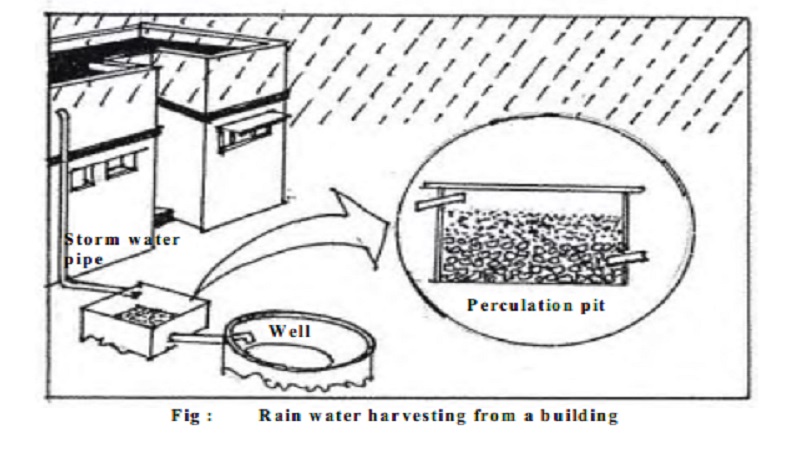Chapter: 11 th 12th std standard Bio Botany plant tree Biology Higher secondary school College Notes
Conservation of Water and Types of Harvesting Rainwater

Conservation of Water
Water Resources
Underground water is available in the crevices of rocks, and between the soil particles. The layers of earth which contain such water form the underground water table. Only certain depth under the earth will be filled with underground water. The upper surface of such stagnant water is called underground water level. The underground water level will vary from 1-100 mts depending upon the place. The water taken out from the water table is compensated every year through monsoon rain.
Importance of Rain Water
The Rainwater plays a vital role in the water cycle of the earth. Rainwater is the main source for rivers, lakes, and underground water. Nowadays, we depend mainly on the above said water resources for our water needs. In such as situation, the importance of rainwater is not realised much. Rainwater Harvest means understanding the importance of rainwater and using the same in all the catchment areas without wasting.
Reasons for water scarcity
1. The water sources are used to the maximum level in order to meet the needs of the growing population of the cities.
2. The increasing buildings, tar and cement roads occupy the open space and these prevent the percolation of natural rainwater into the earth.
3. The failure of monsoon rains brings about increased water scarcity.
4. Usage of underground water becomes more during poor rainfall.
5. Excessive pumping of underground water reduces the water level and the wells become dry.
6. Rainwater is the only source for all the available water.
7. Thus, in order to maintain the underground water resources, we have to conserve rainwater in the underground water table. Rainwater Harvest is the only solution to overcome water scarcity.
Rain Water Harvesting
Types of Harvesting Rainwater
Collection of rainwater during rainy season and allowing this water to percolate into the soil is known as rain water harvesting.
1. Rainwater can be harvested in two ways, depending on the rate of rainfall.
2. We can collect the rainwater directly in big troughs and the same when we used when needed.
3. The underground water resources can be improved by introducing special rainwater harvesting systems into the earth.
Rainwater harvesting depends upon the annual rainfall, area of rainwater harvesting and the amount of rainwater that may percolate into the soil.
The average rain fall
in Chennai - 1200mm (1.2 m)
The rain fall in a
housing plot of
2400 sq.ft. - 223 x 1.2 = 267
(cubic metre)
2,67,000 litres.
Of this the rate of
rainwater sent into
the earth - 1,60,000 lit.
(per year)
We can avoid water scarcity by sending back 1,60,000 litres of rainwater into the earth through rain water harvesting.
Rainwater can be harvested from the following;
i. The rainwater falling on the open terrace
ii. The rainwater falling on the open space around the buildings.
iii. If a house has well or borewell, the rainwater from the open terrace can be harvested very easily.
iv. The rainwater from the open space can be harvested through a proper rainwater harvesting system.
I. Collection of Rainwater from terrace and open spaces.
a. To collect through open wells.
b. To collect through bore wells.
Method of collecting
1. Method of water soaking pits
2. Water soaking pits with perforation
3. Water soaking beds (trenches)
4. Shallow water supplying well
5. Deep water supplying well.
Method to Harvest Rainwater from thatched Roofs/Tiled Roofs
1. The water from the roof can be brought through pipes and sent through sand filters.
2. Polythene sheets can be spread over thatched huts and the water from it can be collected.
The water cleaned through sand filter can be saved in troughs and used.
Rain water harvest through open wells
Water falling on the open terrace can be collected through pipes and let into the well or earth level storing trough.
1. The filtering trough should be made as follows.
2. Broken bricks or pebbles are to be laid one feet height at the bottom.
3. The top level of the trough must be filled with river sand.
4. The trough can be closed with a cement slab if necessary.
Rainwater Harvest through Bore Wells
The water falling on the open terrace can be sent into the bore well through pipes and filtering pit.
The filtering trough is to be made as indicated in the diagram. The overflowing rainwater can be let into the soaking pit
Rainwater also can be harvested through the bore well which are not under use.
Rainwater penetrating level will be lower in the bore well than the open well.
Seepage pit - construction
It can be constructed in the open space around the house. Pits can be in the form of square / rectangle or a circle.
The pits are to be filled with broken bricks, pebbles and river sand. This method is suitable for sandy areas.
One such pit is needed for every 300 sq.ft. area.
Seepage pits with perforation
At the centre of the above said soaking pit, a bore well is to be erected. The bore well must be of 150 - 300 mm radius and 10-15 feet depth.
It is to be filled with the broken bricks and pebbles This method is suitable for area with clayey soil One such pit is needed for 3000 sq.ft. area.
Water Soaking Trench
This pit is made in lengthwise direction
Length 3 to 15 feet
Breadth 1 to 3 feet
Depth 3 to 4.5 feet
The Trench is to be filled with broken bricks, pebbles and river sand. This is suitable for sandy areas.
Related Topics